Teaching Climate Change Through Social and Emotional Learning
High school students may feel anxious when studying climate change. Teachers can use SEL strategies to help them develop healthy coping skills.
Your content has been saved!
Go to My Saved Content.“It feels hopeless.”
“It’s just depressing.”
“I understand why we are learning it, but it feels pointless at the same time.”
I saw these sentiments expressed as I clicked through my students’ written responses. In class, we were learning about the basic physics behind the greenhouse effect in the first half of a climate-heavy unit, and I had asked my students two simple questions: “How do you think these climate lessons are going?” and “How valuable is understanding the science behind climate change to you?”
As I read their writings, the extent of my students’ eco-grief, a term used by mental health professionals to describe feelings of loss related to changes in the environment, became clear to me. It wasn’t particularly surprising. But it was the first time I had really paused and thought explicitly about how our youth’s developing minds were being impacted by the climate crisis. How were they coping, if at all? Like many of the educators who have been front-row witnesses to the explosion of the youth mental health crisis, I was at a loss. Much like climate change, young people’s feelings of hopelessness and despair feel overwhelming, complex, and depressing.
But when I was confronted with my students’ honest reviews of the direction of my lessons, I realized that there was an opportunity, when teaching about the climate, to acknowledge anxiety and grief in a productive way. Inspired by my students’ initial reactions, I made two key changes to the way I teach about climate change that I invite other teachers to replicate.
A New Approach to Teaching the Climate Crisis
First, I incorporated a number of social and emotional learning activities throughout my climate change lessons to help students grapple with and name climate anxieties. I was honest about my own climate anxieties and encouraged discussion so that students could take advantage of the existing classroom community to help combat the loneliness of eco-grief.
For example, when my students learned about the albedo ice effect, a climate phenomenon in which the melting of sea ice increases the percentage of sunlight absorbed by oceans, thus resulting in more melting of sea ice, I noticed an opportunity to introduce a key science concept: the idea of a positive feedback loop, in which an initial stimulus creates conditions for more growth of that initial stimulus.
After students became comfortable with this idea, I invited them to extend its application to our emotional states—both “good” and “bad.” Students reflected on how sometimes, much like the melting of sea ice, negative emotions can spiral out of control. They then identified activities that could help them in times of distress—strategies that could create their own positive feedback loop, allowing students to feel grounded and experience more and more relief with practice. Students enjoyed sharing their favorite calming activities, such as breathing exercises and go-to songs, and the lesson elicited the greatest student engagement that I saw that year.
Promoting Student Agency Through Action-Oriented Curricula
The second change that I made was to anchor my physics lessons in climate phenomena that are more action- and solution-oriented. Students had active discussions on the environmental racism that existed in their own communities. They read about youth climate activists their own age having a real impact on highway legislation in Portland. Our sound waves lesson invited students to explore a real-life tool used to measure ocean temperatures (ocean acoustic tomography), and lessons on the law of conservation of energy led to research projects in renewable energy sources.
The purpose of these lessons was not to sell a falsely positive reality but to put a focus on what people are already doing and the tools they are already using, to learn about and fight climate change while highlighting the work that still needs to be done. Students have to be able to visualize themselves, with their own individual skills and talents, as having the potential to be part of a multifaceted solution to this complex problem.
With the addition of actual practice using healthy coping strategies in the classroom to the more relevant and intentional climate lessons, I saw a noticeable increase in student participation, interest in the subject matter, and quality of student work. We did not solve climate change, but that wasn’t the point. The point was what the students got out of it anyway and what they might carry with them into the world beyond our classroom.
The Need for Intentional Climate Curricula
In my opinion, we have to teach about climate change; there’s no way around it. Bringing the topic into the classroom in a controlled, intentional, and solution-oriented manner can lead to more student engagement and be a powerful tool in the development of healthy coping skills in our youth. Educators should be given the time, resources, and money to pool their talents and develop climate change curricula that are intentional and relevant to students’ local communities.
If done with the intention of arming our youth with the social and emotional skills to cope with the climate crisis, climate change curricula can be a vehicle for the learning and practicing of healthy coping strategies, communication, collaboration, and problem-solving.
